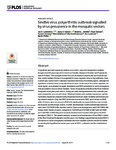Sindbis virus polyarthritis outbreak signalled by virus prevalence in the mosquito vectors
Lundström, Jan O.
Hesson, Jenny C.
Schäfer, Martina L.
Östman, Örjan
Semmler, Torsten
Bekaert, Michaël
Weidmann, Manfred
Lundkvist, Åke
Pfeffer, Martin
Polyarthritis and rash caused by Sindbis virus (SINV), was first recognised in northern Europe about 50 years ago and is known as Ockelbo disease in Sweden and Pogosta disease in Finland. This mosquito-borne virus occurs mainly in tropical and sub-tropical countries, and in northern Europe it is suggested to cause regularly reoccurring outbreaks. Here a seven-year cycle of SINV outbreaks has been referred to in scientific papers, although the hypothesis is based solely on reported human cases. In the search for a more objective outbreak signal, we evaluated mosquito abundance and SINV prevalence in vector mosquitoes from an endemic area in central Sweden. Vector mosquitoes collected in the River Dalälven floodplains during the years before, during, and after the hypothesised 2002 outbreak year were assayed for virus on cell culture. Obtained isolates were partially sequenced, and the nucleotide sequences analysed using Bayesian maximum clade credibility and median joining network analysis. Only one SINV strain was recovered in 2001, and 4 strains in 2003, while 15 strains were recovered in 2002 with significantly increased infection rates in both the enzootic and the bridge-vectors. In 2002, the Maximum Likelihood Estimated infection rates were 10.0/1000 in the enzootic vectors Culex torrentium/pipiens, and 0.62/1000 in the bridge-vector Aedes cinereus, compared to 4.9/1000 and 0.0/1000 in 2001 and 0.0/1000 and 0.32/1000 in 2003 Sequence analysis showed that all isolates belonged to the SINV genotype I (SINV-I). The genetic analysis revealed local maintenance of four SINV-I clades in the River Dalälven floodplains over the years. Our findings suggest that increased SINV-I prevalence in vector mosquitoes constitutes the most valuable outbreak marker for further scrutinising the hypothesized seven-year cycle of SINV-I outbreaks and the mechanisms behind.
Dateien zu dieser Publikation

